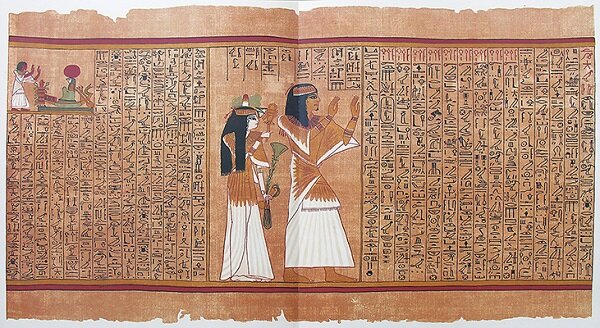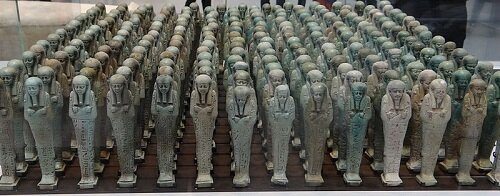The Sunday Section: Ancient Egypt - Magic, and Spells in the Book of the Dead
Papyrus of Ani
In Ancient Egypt, magic was an integral part of religion, binding spirit and matter together. It had nothing to do with the ability to perform fantastical feats, instead it served a practical purpose. Magic was the means by which pain was relieved; life was extended and eased; the well-being of the individual and society was advanced. This was done through healing prayers and spells against evil. Tools were also used, and these included:
Amulets - like the djed pillar, which symbolised Osiris; the scarab; the Isis knot … these items were worn hung from a chain or cord, or bound to the body, and were believed to enhance positive forces, and ward off evil.
Gold and precious stones – gold was believed to be the skin of the gods; silver represented their bones; and precious stones, their hair.
Waxen figures – used as the receptacles of hate and anger.
Knots and numbers – a magic knot was said to be the convergence of the forces of the earth and the divine. A number was considered to be an abstraction of a knot. In the ‘Leyden Magical Papyrus’, the number 7 is believed to be undeniably powerful.
The substitute body, or shabtis (‘those who answer’) – these are wooden models of humans which were entombed with royalty and nobles to perform duties for the dead in the next world.
Letters to the dead – letters from the living to their deceased relatives, asking for forgiveness, assistance and guidance.
Lamp – a special light that was used to divine the existence of good or evil forces.
The most famous collection of spells has to be the Book of the Dead. Words were considered powerful, and speaking or writing the prescribed words for a spell invoked magic or heka. Usually written on papyrus rolls, these spells were buried with the deceased to protect and sustain him in the afterlife, and were the means to overcome the obstacles and dangers the deceased faced on his way to eternal paradise. This meant entering regions the living could not go – the sky-realm of the sun god Ra, and the Netherworld, or Duat, the kingdom of Osiris. The spells also allowed the deceased to exert control over his being without having to depend on the living to ensure his spirit was kept alive.
Ra
Osiris (from the tomb of Nefertari)
Far from being a statement of beliefs, The Book of the Dead was more of a guide to the afterlife. What differentiates them from the earlier Pyramid and Coffin Texts is the inclusion of illustrations, with the pictures considered as powerful as the texts.
As already mentioned in the 'Mummification' post, although the ba of the deceased was able to move freely, it had to return to the body every night; this meant the journey to the afterlife did not happen once but was a cycle to be eternally repeated.
‘ May you cause my ba to come to me from wherever it may be … O heavenly ones, do not appropriate my ba. If you're allowing my ba to see my corpse is delayed, you shall find the Eye of Horus standing up against you …’ ~ Spell 89, ‘for letting a ba rejoin its corpse’
Once in the sepulchre, the mummy was associated with the body of Osiris, and so was surrounded by the same magical protection that was afforded to Osiris by the deities who watched over him and ensured his resurrection – Anubis, the sister-goddesses Isis and Nephthys, and the four sons of Horus. Spell 151 contained the words of these deities, and the words to activate the 4 special amulets which were mounted on mud bricks and placed in niches in the walls of the burial chamber …
‘O you who come seeking to repel my steps, you whose face is hidden; your hiding place is illuminated. I am he who stands behind the djed pillar, I am indeed he who stands behind the djed pillar on the day of preventing slaughter. I am the protection of the deceased.’ ~ Spell 151, text for the djed pillar.
‘You have your blood, O Isis; you have your power, O Isis; you have your magic, O Isis. The amulet is a protection for this Great One, which will drive away whoever would commit a crime against him.’ ~ Spell 156, ‘for a knot-amulet of red jasper’
The four amulets (L to R): the djed pillar, the Isis knot, the heart amulet and the headrest (Papyrus of Ani)
The head of the mummy was covered by a mask; this represented the deceased as a transfigured spirit, and was called the ‘head of mystery’; the figures of deities on the back of the mask provided added protection.
Figures of deities on the back of a mask (Spell 151)
The Duat, the realm of the dead, was very similar to the land of the living in that it had land, rivers, fields, and lakes, but it also had lakes of fire and walls of iron, and was inhabited, not only by the gods, but also by many strange creatures. The deceased was required to pass through a series of gates, which symbolised the transition the spirit had to go through.
Spell 146 - the second of 21 gates with its lion-headed guardian …
The name of the gate is ‘Lady of Heaven, Mistress of the Two Lands, the Wailer, Lady of All, who numbers all men’ (Papyrus of Ani)
Spell 148, which depicts some of the inhabitants of the afterlife. The deceased had to know the name of the bull and his seven cows, and list them in order so as to receive sustenance …
‘The names of the cattle are:
Mansion of Kas, Mistress of All.
Silent One who dwells in her place.
She of Chemmis whom the god ennobled.
The Much Beloved, red of hair.
She who protects in life, the particoloured.
She whose name has power in her craft.
Storm in the sky which wafts the god aloft.
The Bull, husband of the cows.’
This shows the bull and his seven cows; on the upper left are the four rudders of the sky with their deities (Papyrus of Nakht)
Spell 17. The Eye of Horus, or wedjat, was a powerful symbol of protection.
The wedjat (Papyrus of Ani)
Spell 17 – ‘… To me belongs yesterday, I know tomorrow’. This was an indirect reference to the gods Osiris and Ra; their connection to one another symbolised the eternal cycle of life – each night, when Ra journeyed through the Netherworld, and after his battle with the chaos-serpent, Apep, he would be briefly united with Osiris and rejuvenated.
The Book of the Dead also contained spells which gave the deceased the opportunity to play an active role in defending himself and driving away creatures that might attack him on his road to eternal life, creatures like snakes and crocodiles, even insects because certain types of beetle devoured corpses.
‘Get back! Retreat! Get back, you crocodile! Do not come against me, for I live by my magic. May I not have to tell this name of yours to the Great God who sent you.’ ~ Spell 31, ‘for driving off a crocodile’
Nakht fighting off three crocodiles who have come to steal his magic power (Papyrus of Nakht)
The deceased wasn’t simply allowed admittance to the afterlife.
First, he had to face judgement by the gods to see if he had lived his life in accordance with the principles of Maat, the Egyptian concept of order, right and truth. In the judgement hall, the dead had to answer questions to show he was worthy to enter.
He then had to approach each one of the 42 assessors and address them correctly; with names like ‘Blood-eater, who came forth from the slaughter-block’, it could not have been easy. Before each one, he also had to declare himself innocent of a specific sin.
The 42 assessors in the Hall of Judgement (Papyrus of Nu)
Deities sitting as witnesses to the judgement of Ani - (L to R) Ra, Atum, Shu, Tefnut, Geb, Nut, Isis and Nephthys, Horus, Hathor, Hu and Sia. They are also the regular occupants of Ra’s celestial boat (Papyrus of Ani)
Finally, the heart of the deceased, regarded by the Egyptians as the seat of the mind, was examined by the gods, and weighed in a balance by Anubis. A life free from sin resulted in a correct balance.
But this wasn’t enough for the heart contained knowledge of all its owner’s deeds, and it might betray the owner at the last moment. Spell 30B commanded the heart not to testify against its owner:
‘O my heart of my mother … Do not stand up as a witness against me, do not be opposed to me in the tribunal, do not be hostile to me in the presence of the Keeper of the Balance!’
Failure of the test resulted in the deceased being handed over to the Devourer, a crocodile, lion, hippopotamus hybrid, and the executioner of the condemned.
Thoth, the scribe of the gods, then wrote down the result – ‘I have judged the heart of the deceased, and his soul stands as a witness for him. His deeds are righteous in the great balance, and no sin has been found in him.’
Spell 125 and 30B - The weighing of the heart (Papyrus of Hunefer)
Spell 125 - Osiris enthroned in a shrine in the Hall of Judgement, attended by his sister-wives, Isis and Nephthys, with the 4 Sons of Horus facing him (Papyrus of Ani)
In the afterlife, the deceased would be allowed to board the sun god’s boat and be accepted as part of the god’s entourage. He would be expected to join the sun-god in his nightly journey through the Netherworld, to take part in the battle against Apep, after which comes the renewal of life at sunrise. The deceased was also allowed access to the kingdom of Osiris via specific spells.
Spell 16 - The Sun God is shown here in 3 forms - Ra (daytime), Atum (evening), Khepri (morning sun) (Papyrus of Hor)
‘May he grant that I see the sun-disc and behold the moon unceasingly every day; may my soul go forth to travel to every place which it desires; may my name be called out, may it be found at the board of offerings; may there be given to me loaves in the Presence like the Followers of Horus …’ ~ Spell 15
Spell 92 - Ani opening the door to his tomb so his spirit can leave and re-enter (Papyrus of Ani)
Paradise for the Egyptians was a return to the familiar world and its comforts but free from the troubles that beset the living. Called the Field of Offerings or the Field of Reeds, the landscape resembled that of the Nile, with areas of dry land divided up by waterways. Here the dead planted and harvested crops, which grew to towering heights, and they met the gods and were reunited with long-dead family members.
To avoid the manual labour that was required to prepare the land and grow the crops, the deceased could use Spell 6; this activated the shabtis, which would do his work for him.
Spell 110 - The Field of Reeds (Papyrus of Ani)
Troop of shabtis (funerary servant figures in the name of Neferibreheb (Image by Serge Ottaviani)
















